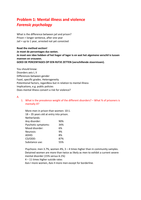Problem 1: Mental illness and violence
Forensic psychology
What is the difference between jail and prison?
Prison = longer sentence, after one year
Jail = up to 1 year, arrested not yet convicted
Read the method section!
Je moet de percentages dus weten.
Je moet een idee hebben of het hoger of lager is en wat het algemene verschil is tussen
mannen en vrouwen.
GOED DE PERCENTAGES OP EEN RIJTJE ZETTEN (verschillende stoornissen).
You should know:
Disorders axis I, II
Differences between gender
Fazel, specific grades. Heterogeneity
Potentional factors, regardless but in relation to mental illness
Implications, e.g. public policies
Does mental illness convert a risk for violence?
A.
1. What is the prevalence weight of the different disorders? – What % of prisoners is
mentally ill?
More men in prison than women: 10:1.
18 – 35 years old at entry into prison.
Netherlands:
Any disorder: 90%
Pyschotic symptoms: 34%
Mood disorder: 6%
Neurosis: 9%
ADHD: 8%
CD/ODD: 87%
Substance use: 55%
Psychosis: men 3.7%, women 4%, 3 – 4 times higher than in community samples.
Detained women are more than twice as likely as men to exhibit a current severe
mental disorder (15% versus 6.1%)
4 – 11 times higher suicide rates
Axis I more women, Axis II more men except for borderline.
, 2. Which mental disorders are most common (make a distinction between Axis I and
Axis II Personality disorder/ major mental disorder.
Axis I is the classification of the most common psychiatric illnesses. Axis II focusses on
personality disorders.
Multiple axis to have a clear and complete system. I acute symptoms, II lifetime, III
neurological or medical, IV … problems V daily functioning.
B.
3. Which factors might influence behavior next to mental disorders?
Next to mental disorders, there are other factors that influence behavior.
Appelbaum: Age, gender, diagnosis and type of criminal offense all affect the odds
ratios for violent convictions and the percentage of crimes attributable to persons
with psychoses. Among the variables that have been identified as increasing the risk
of violence, in addition to psychotic symptoms and substance abuse, are
socioeconomic status and even the neighborhoods in which persons with mental
disorders reside.
Elbogen: Substance abuse and/or dependence. Multivariate analyses revealed that
severe mental illness alone did not predict future violence; it was associated instead
with historical (past violence, juvenile detention, physical abuse, parental arrest
record), clinical (substance abuse, perceived threats), dispositional (age, sex, income),
and contextual (recent divorce, unemployment, victimization) factors.
Silver: Stressful life events and impaired social support
4. Are people with mental disorders more violent than the general population?
There were many different studies about this question. But in general, the answer is
yes. The people with mental disorders are more violent than the general population.
, Appelbaum: In general, studies have shown an elevated risk for violence among
persons with mental disorders. But the proportion of violence that they account for is
relatively small, suggesting that the well- documented public perception of the
mentally ill as dangerous persons is substantially exaggerated.
Elbogen: This study clarifies whether or how severe mental illnesses such as
schizophrenia, bipolar disorder, and major depression lead to violent behavior.
Bivariate analyses showed that the incidence of violence was higher for people with
severe mental illness, but only significantly so for those with co- occurring substance
abuse and/or dependence. Multivariate analyses revealed that severe mental illness
alone did not predict future violence; it was associated instead with historical (past
violence, juvenile detention, physical abuse, parental arrest record), clinical
(substance abuse, perceived threats), dispositional (age, sex, income), and contextual
(recent divorce, unemployment, victimization) factors.
Silver: Furthermore, we found strong evidence that stressful life events and impaired
social support are key factors affecting the social distribution of violence in the
general population. The finding that life stress and impaired social support had
significant independent effects on violence after controlling for demographic
characteristic and mental disorder provides considerable empirical support for the
further exploration of a social stress approach to explaining violent behavior.
Mental disorder stressful life events and impaired social support violence




